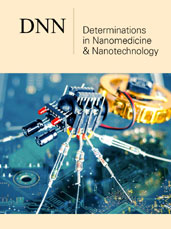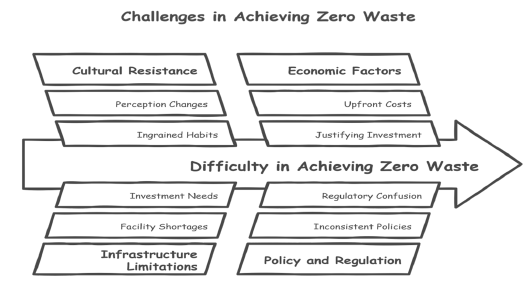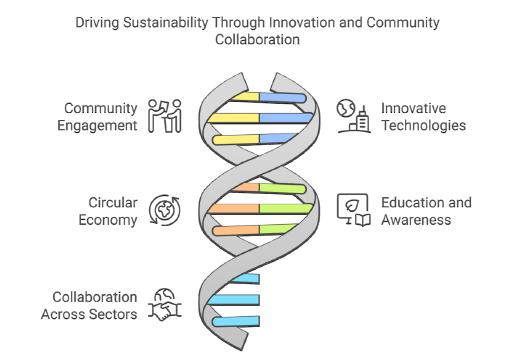- Submissions

Full Text
Determinations in Nanomedicine & Nanotechnology
Achieving Zero Waste: Sustainable Strategies for a Resilient and Regenerative Society
Bakale Raghavendra1, Mathad Shridhar2*, Ashok Lakamanahalli3, Urvi Rendale4 and Shivalingsarj V Desai5
1Department of Chemistry, Jain College of Engineering, India
2Department of Physics, K L E Institute of Technology, India
3Department of Electronics and Communication, K L E Institute of Technology, India
4KLE Homoeopathic Medical College and Hospital, India
5Department of Biotechnology, KLE Technological University, India
*Corresponding author:Mathad Shridhar, Department of Physics, K L E Institute of Technology, Hubballi, India
Submission: June 04, 2025;Published: July 21, 2025

ISSN: 2832-4439 Volume3 Issue 3
As the world grapples with the challenges of climate change, environmental degradation, and social inequality, the need for sustainable solutions has never been more pressing. One critical area of focus is waste management, with the ambitious goal of achieving zero waste. In this, we will explore the importance of zero waste, the challenges and opportunities it presents, and the sustainable strategies that can help us achieve this vision.
Keywords:Zero waste; Sustainable development; Circular economy; Waste management; Environmental sustainability
The Imperative of Zero Waste
The statistics on waste are staggering. According to the World Bank, the world generated 2 billion tons of municipal solid waste annually, with this number expected to increase by 70% to 3.4 billion tons by 2050 unless urgent action is taken. The environmental, social, and economic impacts of this waste are severe, from greenhouse gas emissions and pollution to health problems and economic losses. “Zero waste” refers to a holistic approach where products and systems are designed and managed with the primary goal of minimizing waste generation by maximizing resource efficiency, essentially aiming to eliminate waste by reusing and recycling materials throughout their lifecycle, thus providing a strong solution to environmental concerns related to waste disposal and resource depletion. This offers a compelling solution to the diverse challenges. By adopting zero waste strategies, we can reduce greenhouse gas emissions, conserve natural resources, and promote sustainable economic growth.
Challenges and Opportunities
Achieving zero waste is a complex and multifaceted challenge that requires the engagement of governments, businesses, civil society, and individuals (Figure 1). One of the primary obstacles is the existing linear economy model, which is based on a “take, make, dispose” approach. This model is inherently wasteful and unsustainable, and it must be transformed into a circular economy model that prioritizes reuse, recycling, and waste reduction. Another challenge is the lack of infrastructure and financing for zero waste initiatives. In many countries, waste management systems are inadequate, and the necessary investments in recycling facilities, composting plants, and waste-to-energy technologies are not being made. Despite these challenges, there are many opportunities for innovation and progress. The growth of the circular economy, the increasing adoption of sustainable consumption and production patterns, and the development of new technologies and business models are all contributing to a shift towards zero waste (Figure 2).
Figure 1:Challenges in achieving zero waste.

Figure 2:Opportunities for sustainable strategies.

Sustainable Strategies for Zero Waste
So, what are the sustainable strategies that can help us achieve
zero waste? Here are some of the most promising approaches:
a. Design for recyclability and reusability: Products
and packaging should be designed to be recycled, reused, or
biodegradable, reducing waste and the continuous demand for new
raw materials.
b. Implement extended producer responsibility:
Manufacturers should be held responsible for the waste generated
by their products, encouraging them to design more sustainable
products and packaging.
c. Invest in recycling and composting infrastructure:
Governments and businesses should invest in modern recycling
and composting facilities, increasing the amount of waste that is
recycled and reducing the amount sent to landfills.
d. Promote sharing and collaborative consumption:
Sharing economies and collaborative consumption models can
reduce waste by promoting the sharing of goods and services
rather than individual ownership.
e. Educate and engage communities: Raising awareness
and engaging communities in zero waste initiatives is critical to
changing behaviors and promoting sustainable lifestyles.
f. Implement waste-to-energy technologies: Waste-toenergy
technologies can convert non-recyclable waste into energy,
reducing greenhouse gas emissions and dependence on fossil fuels.
g. Support circular economy business models: Businesses
should adopt circular economy models that promote the reuse and
recycling of products, reducing waste and the demand for new raw
materials.
Conclusion
Achieving zero waste is a challenging but essential goal for creating a resilient and regenerative society. By adopting sustainable strategies such as design for recyclability, extended producer responsibility, and investing in recycling infrastructure, we can reduce waste, promote sustainable consumption and production patterns, and mitigate the environmental, social, and economic impacts of waste. However, achieving zero waste requires a fundamental transformation of our linear economy model and the engagement of all stakeholders, from governments and businesses to civil society and individuals. It requires a shift in our values and behaviors, from a culture of consumption and waste to a culture of sustainability and stewardship. Together, we can create a zerowaste future that is more equitable, just, and sustainable for all.
 a Creative Commons Attribution 4.0 International License. Based on a work at www.crimsonpublishers.com.
Best viewed in
a Creative Commons Attribution 4.0 International License. Based on a work at www.crimsonpublishers.com.
Best viewed in 







.jpg)






























 Editorial Board Registrations
Editorial Board Registrations Submit your Article
Submit your Article Refer a Friend
Refer a Friend Advertise With Us
Advertise With Us
.jpg)






.jpg)














.bmp)
.jpg)
.png)
.jpg)










.jpg)






.png)

.png)



.png)






